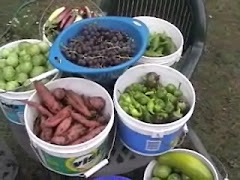 The grandson and I decided to hunt for buried treasure this afternoon, as he is currently in a pirate phase. We soon unearthed our booty in the form of sun roots... "Are those potatoes grandpa?" he asked somewhat disappointed. I spend a great deal of time teaching the boy about things, many things , and today was a lesson on sunroots, sunchokes, Jerusalem Artichokes, or any number of names. I like sunroots as that is supposed to be what the original (native) Americans called one of this country's few indigenous tubers.
The grandson and I decided to hunt for buried treasure this afternoon, as he is currently in a pirate phase. We soon unearthed our booty in the form of sun roots... "Are those potatoes grandpa?" he asked somewhat disappointed. I spend a great deal of time teaching the boy about things, many things , and today was a lesson on sunroots, sunchokes, Jerusalem Artichokes, or any number of names. I like sunroots as that is supposed to be what the original (native) Americans called one of this country's few indigenous tubers.
A relative of the sunflower it is most delicious raw on salads or cooked in soups, and can also be mashed as a potato would be. Raw, you will find a crisp crunchy texture and a flavor that I can't quite communicate other than to say they have a fresh, clean, subtly sweet essence to them. Cooked they are similar in flavor to a cross between a mild turnip and potato perhaps.

He had helped me last fall as I mounded layers of dirt and leaves around the stalks in order to protect them from the winter cold. I cut the stalks back in autumn but left about 3 feet so that we could find them under cover of snow, as in X marks the spot. The boy, being only four, this was a distant memory and the sunroot story had to be retold as we carefully dug up the buried treasures.

My young apprentice was soon off on other adventures and relayed to me that he had discovered the first butterfly of spring. It was indeed a butterfly, but perhaps not destined to be part of this coming spring as it appeared to have long since passed away.
























2 comments:
Beautiful article. I agree the name "sun roots" is more apt -- it certainly never came from Jerusalem. These are one of the "foods for the future", such as groundnut or "apios americana", a wild potato with more protein than our common one. Question? Can this plant be also harvested during winter??
Hi Nancy,
I agree that sun roots could be a food for the future. The plants are so hardy and prolific.
We harvest them all winter, I simply cover them in leaves or grass to protect against winters chill making sure to leave some of the stalk so they can easily be found in the snow. They can be eaten fresh from the garden all year, it's just a matter of digging them up.
I have read about groundnuts and even foraged for them, but have yet to find or try any. They are supposed to grow wild in my area. I recently saw a nice article on them at this site.
http://www.wwmag.net/wapato.htm
One of the potatoes I grow "Anna Cheeka Ozette" reportedly comes from a Native American village on the Olympic Peninsula and is said to have been brought from Peru in the late 1700s by Spanish explorers, where it was traded to the Makah/Ozette band that lives at Neah Bay, Washington.
Thanks for visiting,
Mike
Post a Comment